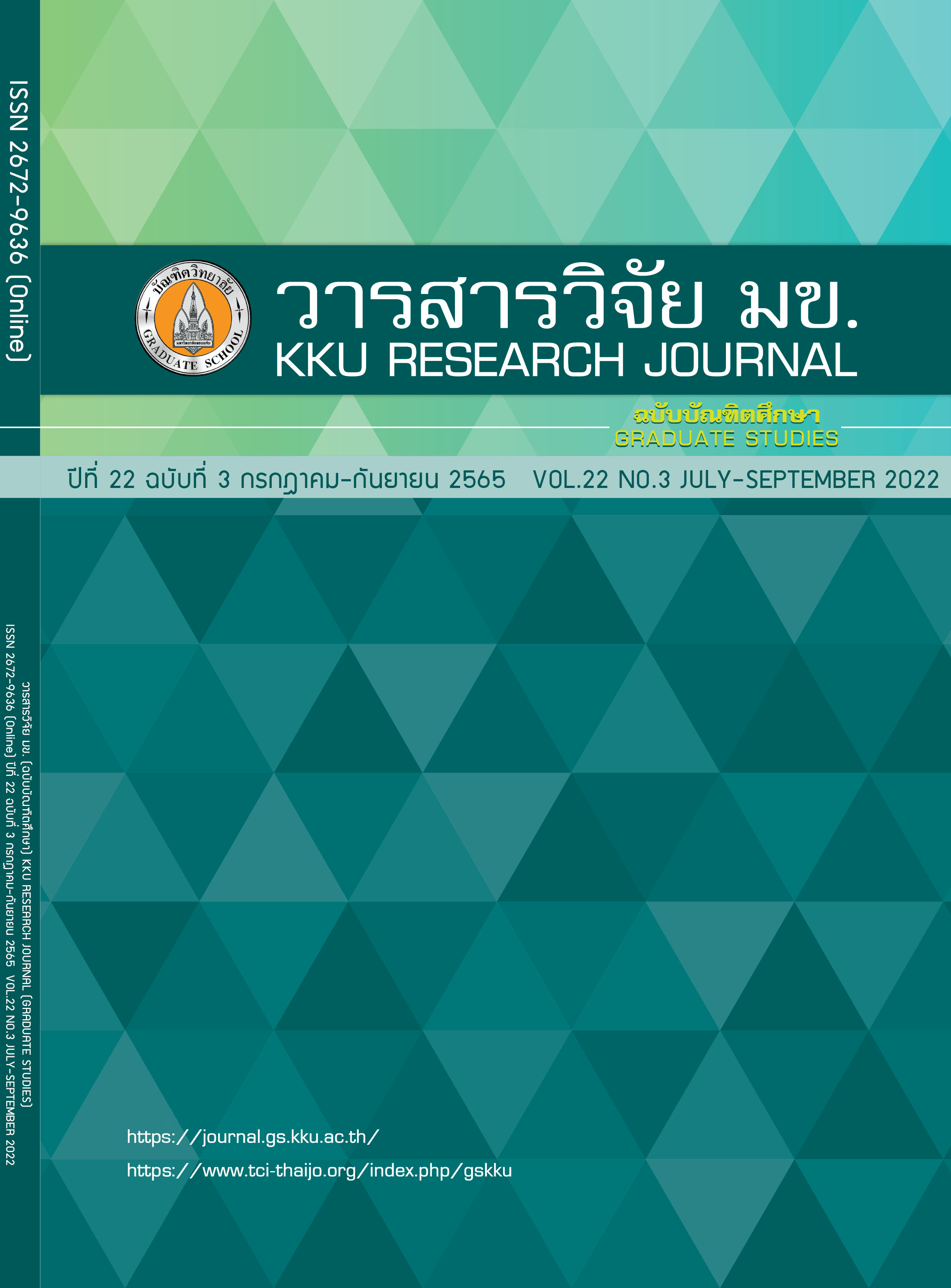Combining Unmanned Aerial Vehicle Photogrammetry with Multi-Criteria Decision-Making Technique to Analyze Dengue Breeding Area in Khon Kaen University
Keywords:
Geo-spatial data, Analytical hierarchy process, Aedes mosquito breedingAbstract
This article aims to develop an approach to analyze geo-spatial data from multi-platform such as unmanned aerial vehicle and satellite imagery including Sentinel-S2 and Landsat-8 data, employing geospatial-based multi-criteria decision-making (Geo-based MCDM) techniques. Using Geo-based MCDM in Terrset Software, the weight factors obtained from literature review and health professionals were derived as follows: (1) surface-temperature with factor weight of 29.6%; (2) greenspace, 21.7%; (3) water-resource index, 19.0%; (4) building height, 18.6%; (5) land-use, 6.6%; and (6) sewerage system, 4.4%. These weight factors indicated a risk area for Aedes mosquito breeding habitat, dividing results into high, medium and low level of risk. Our finding results reflected the ability to integrate geo-spatial data at multiple resolutions.
References
Dengue Hemorrhagic Fever [Internet]. Department of Disease Control; 2021 [cited 2021 June 29]. Available from: https://ddc.moph.go.th/disease_detail.php?d=6
Thavara U, Tawatsin A, Chompoosru J, Phakdee P. National Institute of Health of Thailand. Biology, Ecology and Mosquito Control in Thailand. Nonthaburi: National Institute of Health. 2001.
Sarfraz MS, Tripathi NK, Kitamoto A. Near real-time characterisation of urban environments: a holistic approach for monitoring dengue fever risk areas. Vol. 7, International Journal of Digital Earth. 2014. p. 916–934.
Li Z, Gurgel H, Dessay N, Hu L, Xu L, Gong P. Semi-supervised text classification framework: An overview of dengue landscape factors and satellite earth observation. Vol. 17, International Journal of Environmental Research and Public Health. 2020. p. 1–29.
Marti R, Li Z, Catry T, Roux E, Mangeas M, Handschumacher P, et al. A mapping review on urban landscape factors of dengue retrieved from earth observation data, GIS techniques, and survey questionnaires. Vol. 12, Remote Sensing. 2020. p. 932.
Sahdev S, Kumar M. Identification and mapping of dengue epidemics using GIS-based multi-criteria decision making. The case of Delhi, India. Vol. 6, Journal of Settlements and Spatial Planning. 2020. p. 61-69.
Pettorelli N, Ryan S, Mueller T, Bunnefeld N, Jedrzejewska B, Lima M, et al. The Normalized Difference Vegetation Index (NDVI): Unforeseen successes in animal ecology. Vol. 46, Climate Research. 2011. p. 15–27.
McFeeters SK. Using the normalized difference water index (ndwi) within a geographic information system to detect swimming pools for mosquito abatement: A practical approach. Vol. 5, Remote Sensing. 2013. p. 3544–3561.
Sarfraz MS, Tripathi NK, Faruque FS, Bajwa UI, Kitamoto A, Souris M. Mapping urban and peri-urban breeding habitats of Aedes mosquitoes using a fuzzy analytical hierarchical process based on climatic and physical parameters. Vol. 8, Geospatial Health. 2014. p. S685–697.
Seidahmed OME, Lu D, Chong CS, Ng LC, Eltahir EAB. Patterns of Urban Housing Shape Dengue Distribution in Singapore at Neighborhood and Country Scales. Vol. 2, GeoHealth. 2018. p. 54-67.
Barrera R, Amador M, Clark GG. Use of the pupal survey technique for measuring Aedes aegypti (Diptera : Culicidae) productivity in Puerto Rico. Vol. 74, American Journal of Tropical Medicine and Hygiene. 2006. p. 290-302.
Downloads
Published
Issue
Section
License
Copyright (c) 2022 KKU Research Journal (Graduate Studies)

This work is licensed under a Creative Commons Attribution-NonCommercial-NoDerivatives 4.0 International License.



